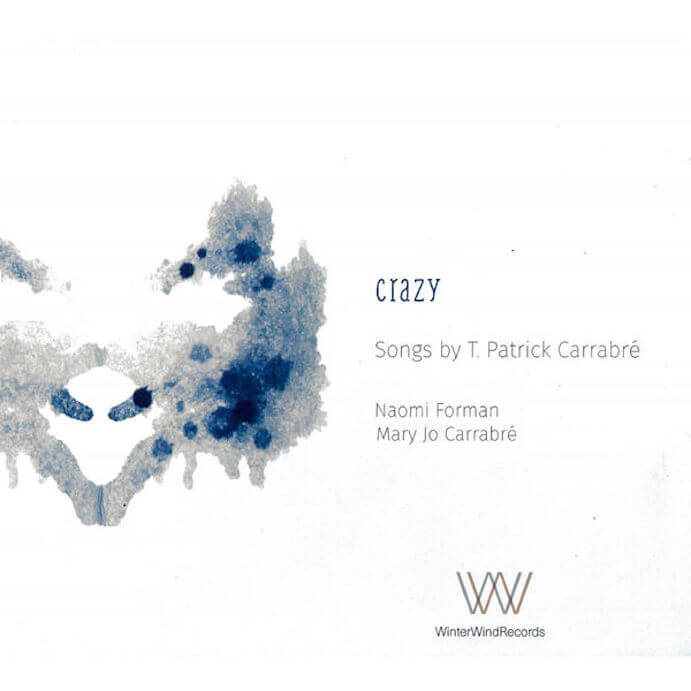Crazy, a song cycle by T. Patrick Carrabré, seeks to explore the line necessary in the creative process that defines “normalcy” in terms of artistic behavior, and whether it is necessary to cross to a darker territory to create. “I’ve often wondered whether you have to go over the edge to reach your potential,” Carrabré states, obviously an impetus to the songs in the cycle: “Death,” “Murder,” “Lust,” “Burnt,” and “Pain.” With Winter Wind Records‘ inaugural release, Carrabré aims to weave together a balance between numerous texts and genres, acoustic and electroacoustic, in order to shed light on the darkness beyond the defined behavioral line.
The opening of the song cycle is “Death,” with text from Rainer Maria Rilke. Immediately, the craftsmanship of neo-romantic harmony and counterpoint is striking. If not for the use of electronics, it would be difficult to recognize that the Lied was not from the late 1800s. Carrabré’s setting of text reveals contemplation of the structure of the work, allowing sometimes intriguingly designed and sparse electronics to be laid onto or behind Schumman-esque melodies, which softly enhance the predictability of structure and material.
“Murder” puts the texts of Carlo Gesualdo and Torquato Tasso to an emotional narrative. While the vocalist, Naomi Forman, pulls out a great deal of passion and pain, abrupt synthesizer cutouts create a disconnect from the harmonious piano textures and strip away the work’s ethos. Moments of blending allow the electronic backdrop to complement the work’s aura, but the overall song creates a disparity between acoustic and electronic timbres.
T. Patrick Carrabré
“Lust” stands out in the cycle, using text by Gérard de Nerval and Johann Wolfgang von Goethe to construct an overall cohesive sonic atmosphere, blending the electronics with the piano and voice. Forman is a perfect fit, as her tone and styling complement the simple melodic content and reinforce the text. Carrabré’s compositional voice finally shows as he finds a subtle blend between electronic and acoustic materials woven together. The only rough edge breaking the smooth narrative in the song is the over-processed spoken-word, which appears sparingly and is hard to understand or reconcile timbrally.
With text by Fredrico Garcia Lorca, “Burnt” takes stereotypical flamenco melodic rifts and places them as primary content in the piano with an underlying kitschy percussive beat in the electronics. While the material was meant as a nod to Lorca, the naïve use of flamenco ornamentation and melody results in an appropriated amalgamation of varying styles. The moments that break from flamenco quotations and the underlying electronic pulse are well balanced, using ethereal electronic sounds to complement the voice and text.
A jauntily whistled folk-song melody a la Percy Grainger, a pulsive kick drum, and metallic drone act as a distraction from the desired interpretation in “Pain.” From the first word, the vocals feel discordant, as if trying to blend the classical style to a new pop-like quality. As the work continues, the simple melody grows but becomes unwieldy, and the electronic backing leans towards Electronic Dance Music, furthering its conflict with the folkish qualities. Later on the album, “Pain” is listed again but as an “audiation remix.” Essentially, this is an EDM remix which is more successful than the original, in that it feels like what the original wanted to be in the first place. The overall context for the remix is odd to include on the album, though it rings more true to the composer’s voice.
The Garden, the only work not part of the song cycle, marks a reprieve from the combining of genres, putting forth the most cohesive song on the album. Using text by Andrew Marvell and Gabriela Mistral, Carrabré’s voice as a neo-romantic composer finally becomes clear. A wonderful expressiveness takes over the phrasing, and the harmonic vocabulary uncovers a previously unfound balance to the melodic content. Forman emanates a delicate aura while being more comfortable in this simple yet effective work.
With a title like Crazy, a much more intense experience was expected. Titles such as “Pain,” “Murder,” and “Lust” offer highly evocative programmatic expectations that largely fell flat on execution. However, the works on this album shows a strong foundation with neo-romantic harmonic structures and high levels of versatility setting text to emotive melodies in common structures. The desire to constantly combine unlike elements served as a distraction, whether that be combining multiple texts into one song, superimposing borrowed Romanic Lied writing, or mixing flamenco-like melodic ornamentation and harmony with a pseudo-EDM beat or synthesizer. The constant borrowing of material reminiscent of or directly stemming from another genre or time period feels forced, shrouding the composer’s voice.
Brief moments of outstanding harmony and color occur with a delicate and complementary balance between piano, voice, and electronics, but those moments are often interrupted by disconnected material. Poor audio mixing, as well, left musicians and electronics unbalanced and disconnected from one another. Forman brings an essential expressive intensity to the song cycle, even though not every song was suited for her more romantic vocal identity. Overall, T. Patrick Carrabré’s album Crazy has its intriguing moments, but largely gets lost to the noise in unnecessary chatter.

